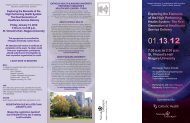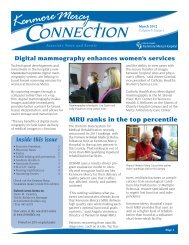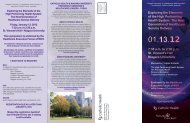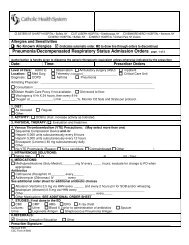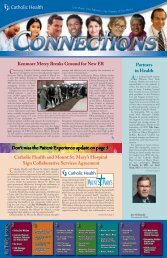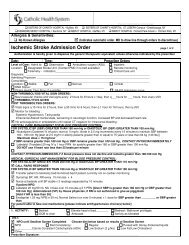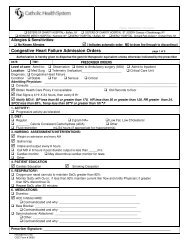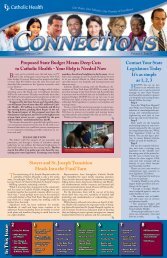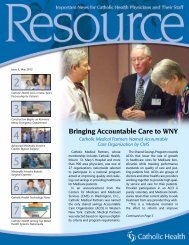Ryan Wilkins, MD
Ryan Wilkins, MD
Ryan Wilkins, MD
- No tags were found...
Create successful ePaper yourself
Turn your PDF publications into a flip-book with our unique Google optimized e-Paper software.
Uncovering the Cause ofYour Shoulder Pain<strong>Ryan</strong> <strong>Wilkins</strong>, <strong>MD</strong>07/18/2013
3Bony Anatomy
Four JointsShoulder consists of fourjoints:‣ 1. Glenohumeral joint‣ 2. Acromioclavicularjoint‣ 3. Sternoclavicularjoint‣ 4. Scapulothoracicarticulation4
Sternoclavicular JointVery stable jointRarely the site of pathologyAllows the clavicle to function as a strutGray’s Anatomy5
Acromioclavicular JointRelies on Ligaments for stabilityAC Joint capsule providesanterior-posterior (Front-back)stabilityCoracoclavicular ligaments– Hold the clavicle down“SeperatedShoulder”6
Scapulothoracic “Joint”
Shoulder Elevation120° GH motion + 60° ST motion = 180° of Elevation
Glenohumeral JointNot a true “ball andsocket”
Bony AnatomySpherical humeralhead (Ball)Shallow glenoid fossa(Tee)shouldersurgeon.com10
Mobility vs Stability
Glenohumeral StabilityStatic StabilizersScapula (Glenoid(Glenoid)Humeral HeadGlenoid LabrumGlenohumeral Ligaments(capsule)Dynamic StabilizersRotator CuffPeriscapular muscles
Glenoid LabrumDeepens the glenoid cavityby 50%Biceps tendon attachessuperiorlyServes as an anchor forattachment of the jointcapsule13
Shoulder CapsuleANTERIORPOSTERIORAnterior CapsulePosterior Capsule
Rotator CuffFour Muscles‣ Subscapularis‣ Supraspinatus‣ Infraspinatus‣ Teres Minor
Rotator Cuff Functions‣ Internal and External Rotation‣ Provides Joint Compression‣ Initiates Elevation‣ Allows the larger muscles (i.e., deltoid) tofunction efficiently16
Rotator CuffMuscles on oppositesides of the joint createa net force allowing forjoint compression17www.orthop.washington.edu
DeltoidThree heads– Anterior (Front)– Middle (Middle)– Posterior (Back)Elevates the humerusRelies on a functioningrotator cuff to workefficiently18
Scapular Stabilizers / RotatorsStabilize / position the scapula to allow forefficient glenohumeral motionlivestrong.com19
Why Does My Shoulder Hurt?
Q: Is it my rotator cuff?A: MAYBE‣ Age USUALLY >40‣ Anterior (front) and Lateral (side) Shoulderpain‣ Reaching and Overhead Activities‣ Weakness (pain related?)
Q: Is it my rotator cuff?A:PROBABLY NOT‣ Age < 30 (exceptions)‣ No Anterior or Lateral Arm Pain‣ No Weakness
nottinghamshoulders.comSub-acromialImpingementMost commondiagnosis for patientspresenting withshoulder pain
Sub-acromialImpingementortho-md.com
Acromion Morphology
Sub-acromialImpingementTreatment– At least 4-646 weeks of conservativemanagement initiallyAvoid aggravating activities / positionsPhysical therapyAcetaminophen/NSAIDsas needed
Positive Response?Continue PTTransition to home exercise program
Persistent Pain?Sub-acromialinjection– Diagnostic andtherapeutic benefitConsider MRI toevaluate for rotatorcuff tear
Acromioplasty
Sub-acromialdecompressionnottinghamshoulders.com,drgartsman.com
Rotator Cuff Tears
Partial Thickness TearsHabermeyer et al, JSESKwon et al, JKOA
Partial Thickness TearsDebride vs Repair50% RuleBig Difference in Recovery– Must be prepared for either(3-6 6 months vs 6-12 months)
Full Thickness RC Tearshttp://orthoinfo.aaos.org
Q: Who Needs Surgery?A: NOBODY!
Q: Who Benefits Most FromSurgery?Young Physiologic AgeAcute TearsHigh Demand PatientsSignificantly Compromised Function– Unable to compensatePersistent pain (repair vs debride)
Lo and Burkhart, AJSMNot All RC Tears Are TheSame!Crescent and U shapedL- Shaped
Not All RC Tears Are TheSmall / Acute TearSame!Large (Massive) /ChronicTearnguyensportsmed.comVaishnav et al, JSES
Rotator Cuff RepairTechniques have advanced tremendously!Open Rotator Cuff Repair Mini-openRotator Cuff Repair All ArthroscopicRotator Cuff RepairCaution! Small incisions, big surgery!
Rotator Cuff Repair - TechniqueAhmad et al,AJSM
Rotator Cuff RepairHealio.com
RC Repair: Post-op op RehabInitial period of relative immobilization– 4-66 weeksRange of Motion– 6 weeks 3 monthsStrengthening– 3 months 6 months
Q: Is it a Frozen Shoulder?Gradual OnsetNo Clear MechanismDiffuse PainWorse at nightProgressive loss of motion
Adhesive Capsulitisa.k.a. “Frozen Shoulder”Idiopathic (sponatneous(– unknown cause)painful, global restriction of shoulder motionRestriction of Both Active and Passive motionMay be secondary to another injury– Use it or Lose it
Frozen Shoulder
Frozen Shoulder: Stage 1Inflammatory Stage: Gradually Increasing Painand Loss of Motion– 0-33 months– Increasing difficulty with simple activities ofdaily livingCombing hairFastening a BraReaching for walletTucking a shirt
Frozen Shoulder: Stage 2Freezing Stage: Stiffness worsens, Painpersists– 3-99 months– Passive motion = Active motion
Frozen Shoulder: Stage 3Frozen Stage: Stiffness persists, Painlessens– 9-15 months– Passive motion = Active motion– PT generally more well-tolerated
Frozen Shoulder: Stage 4Thawing Stage– 15-24 months– Initially minimal pain, but severe restriction inmotion– Effectiveness of PT improves as the capsuleremodels– Gradual, but not complete return of range ofmotion– 15% of patients never regain full range
Who Gets a Frozen Shoulder?Has been described in all age groupsThose at greater risk include:– Women 40-60 years of age– Diabetics (5x)– Thyroid Dysfunction– History of Breast Cancer– Prolonged Immobilzation
AC: Natural HistoryMost Commonly– Self Limited Condition– Lasts 12-24 24 months
Frozen ShoulderNon-Operative Management– Physical Therapy (gentle stretching,mobilizations)– NSAIDs as needed– Glenohumeral and/or sub-acromialinjection
AC: Non-OperativeManagmentManipulationUnder Anesthesia
AC: Surgical ManagementArthroscopicCapsular Release
Frozen Shoulder TreatmentPhysical therapy in any phaseSub-acromialand/or glenohumeral injection(inflammatory and freezing stages)Manipulation +/- arthroscopic release ifsymptoms are intolerable and unresponsivefor at least 3 monthsPT immediately following procedure
Q: Is it arthritis?Final common pathway for manyconditions– Post-traumatictraumatic– Chronic Rotator cuff tears– Multiple “shoulder stabilizing” procedures– General wear and tear– Bad luck
Acromioclavicular Joint Arthritis
AC Joint ArthritisWho?– 50-60 % of asymptomatic people over age 65will have AC joint arthritis on xrays
AC Joint ArthritisWho needs treatment?Pain on top of shoulderTenderness at the AC jointRelief from injection– Typically laborers, weightlifters, recreationalathletes
AC Joint ArthritisNon –Operative TreatmentAvoid aggravating activitiesAnti-inflammatory inflammatory medicationsInjection (Diagnostic and Therapeutic)
AC Arthritis: SurgeryDistal ClavicleExcision:– 5-15 mm of distalclavicle removed– Open or arthoscopicPost-op
Glenohumeral ArthritisRelatively diffuse, “deep” shoulder painPain with activity and following activityFrequent crepitationProgressive loss of fuction
Glenohumeral Arthritis: Xraysshouldersurgery.com
Glenohumeral Arthritis:Non-operative operative TreatmentActivity ModificationGentle PTAnti-inflammatory inflammatory medicationsSteroid Injections‣ Manage the symptoms
Glenohumeral Arthritis:Hemi-resurfacing (PartialReplacement)
GH Arthritis: Total ShoulderReplacementRequires intact rotator cuff for good function
Rotator Cuff Tear ArthopathyChronic rotator cufftearHumeral headmigrates superiorlyArthritis with wear ofthe acromion
Reverse Total ShoulderAllows the deltoidto compensate fora deficient rotatorcuffChanges theresting tension ofthe deltoid andimproves itsmoment armReplacement
Thank You!




